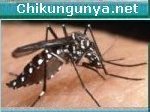ProMedMail reports based on the Thaindian News, that 6 cases of chikungunya have been confirmed in Vatakara and 9 cases confirmed in Maruthonkara, both in Kozhikode district, in the northern part of Kerala state, India. The outbreak was reported Tuesday (04/08/2008), following heavy and untimely rains. The index case appear to be a person who travelled from Tamil Nadu [Is there an outbreak as well in Tamil Nadu? No report on that available.] A high density of Aedes aegypti mosquitoes was noted at the location of the outbreak, and a campaing to reduce the mosquito density has been initiated. According to the report, Kozhikode district, specifically the town of Kodenchery reported a large number of cases last year.
According to another report in the same journal, Poonam Khetrapal Singh, the deputy regional director of WHO SEARO (South-East Asian Region), the chikungunya outbreaks in Kerala in the last two years is directly attributable to climate change. The report claims that 100 fatalities and more than 100,000 [or rather 1,000,000] chikungunya cases occured in Kerala state. Kerala State put together an action plan to control disease, with each district allocated 500,000 Rs for prevention.
These news are very disconcerting as last year the first cases in Kerala have been reported more than a month later than this year. Unless vector control campaigns are much more successful than previously, another huge outbreak of chikungunya in the region is expected this year. This will also enable the importation of chikungunya to Europe and the US, where transmission by local Aedes albopictus is a real possibility.
Click here to see the location of these outbreaks.
Wednesday, April 9, 2008
Monday, April 7, 2008
More information on the dengue outbreak in Rio de Janiero
During the weekend, CNN ran two additional articles on the dengue outbreak in Rio de Janiero containing some additional information. According to the first report, 2000 soldiers and firefighters joined the fight against dengue, some of them going door-to-door to educate the public about source-reduction. Additional to the 67 fatalities already reported, 58 suspected deaths are also investigated. An average of 1.4 cases of dengue are reported per minute (that's 2016 cases per day). 400 patients are admitted to one of the field hospitals, of which 65% have dengue. The reported fatalities are also broken down with 21 due to DHF, 14 due to DSS, while 32 due to the 'more common form of the disease' [possibly these cases do not satisfy all the requirements of the WHO DHF/DSS classification]. According to an article in the newspaper O Globo and ProMedMail, the public health infrastructure in Rio de Janeiro has collapsed under the pressure of the dengue outbreak, amplified by an influx of patients from the countryside. CNN also reports of the difficulty in vector control in Caxias neighborhood of Rio, which is ruled by drug dealers who don't let authorities and outsiders into their territory. Residents are feeling neglected and probably in need of basic public health services.
Thursday, April 3, 2008
Dengue situation worsening in Rio de Janiero
CNN carries today a tragic report on the worsening dengue situation in Rio de Janeiro, Brazil. According to the report, the number of dengue fever cases this year has reached 57,010 , while the number of DHF cases exceeded 513. There were 67 deaths connected to dengue so far, with more than half of those in children below the age of 13. Judged by the report, the public health infrastructure is clearly overwhelmed, with patients transported to 3 military field hospitals near the city (see shocking images at the same CNN report). Authorities are considering to invite assistance from Cuba, where physicians are very experienced at treating dengue. Average hospital waits range from 8 to 28 hrs at different hospitals in the city. Earlier this week, the government also asked other Brazilian states to send hundreds of their physicians to help save the population in Rio. The Brazilian army is also contributing to the efforts. I would encourage any reader of the blog from the region to submit their firsthand reports.
Wednesday, April 2, 2008
New issue of the American Journal of Tropical Medicine and Hygiene published
A new issue of the American Journal of Tropical Medicine and Hygiene has been published. I wish UGA would have a subscription for it such that I could access the articles as they come out. It has a number of interesting articles, but I 'd just like to highlight a few here:
Am J Trop Med Hyg 2008 78: 654-665. [Abstract] [Full Text] [PDF]
- Ephantus J. Muturi, Peter Burgess, AND Robert J. Novak
- Malaria Vector Management: Where Have We Come From and Where Are We Headed?
Am J Trop Med Hyg 2008 78: 536-537. [Full Text] [PDF]
Am J Trop Med Hyg 2008 78: 654-665. [Abstract] [Full Text] [PDF]
- Roberto Barrera, Elizabeth Hunsperger, Jorge L. Muñoz-Jordán, Manuel Amador, Annette Diaz, Joshua Smith, Kovi Bessoff, Manuela Beltran, Edgardo Vergne, Mark Verduin, Amy Lambert, AND Wellington Sun
Am J Trop Med Hyg 2008 78: 666-668. - [Abstract] [Full Text] [PDF]
- William K. Reisen, Ying Fang, AND Aaron C. Brault
Am J Trop Med Hyg 2008 78: 681-686. - [Abstract] [Full Text] [PDF]
- Christopher D. Paddock, Susana Fernandez, Gustavo A. Echenique, John W. Sumner, Will K. Reeves, Sherif R. Zaki, AND Carlos E. Remondegui
Am J Trop Med Hyg 2008 78: 687-692. - [Abstract] [Full Text] [PDF]
Subscribe to:
Posts (Atom)













